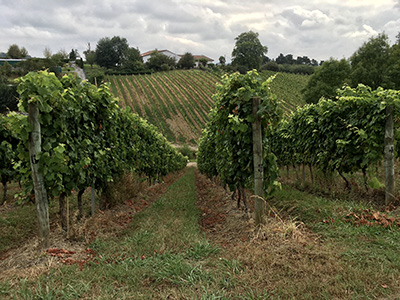Hiruzta
Barrio Jaitzubia, 266, 20280, Hondarribia, Gipuzkoa, Spain
www.hiruzta.com
Located on the border with France, Hondarribia does not seem as strongly connected to txakoli as Getaria or Zarautz. However, documents from the town’s archives mention the existence of vineyards in the area as early as 1186. Further evidence is provided by the bunches of grapes that crowned its coat of arms at the beginning of the 17th century and the numerous toponyms including the term mahasti (vineyard in Basque). Sometime before, in 1581, 13 txakoli producers attended the Council's call to taste and set the price of the wine that year. However, the frequent cross-border battles must have ended in the progressive abandonment of grape growing. The connection is clear between the name of the town and that of the region’s most widely planted grape variety: Hondarrabi Zuri.
The expansion of DO Getariako Txakolina across the province of Gipuzkoa in 2007 encouraged the Rekalde family to recover this lost tradition as well as their rural origins after having been more focused on the construction business.
The winery, surrounded by trellised vineyards, was built by the family in the Jaitzubia district, at the foot of Mount Jaizkibel. At present, Hiruzta has 14 hectares under vine with three more set to be planted soon. Vines sit on clay-limestone sandy soils, with gradients of up to 20%. The steeper areas are picked by hand; the rest are harvested with machines. Hondarrabi Zuri (Gros Manseng) is the dominant grape variety, but there are also a couple of hectares of Hondarrabi Beltza and less than one hectare of Izkiriota Haundi (Gros Manseng). Yields range from 10,000 to 12,000 kg per hectare. Winemaker Ana Martín, with extensive experience in the three txakoli regions, has been consulting them since the start of the business.
Between 150,000 and 200,000 bottles are produced, 40% of which are exported, mostly to the United States and Norway. 75% of the wine is young spritzy txakoli (about €8), slowly fermented at low temperature (15-16ºC) in isothermal tanks to preserve the carbonic gas. Berezia (€12) is made from the oldest vineyard and has been partly aged on its lees. About 1,000 litres of this wine are left aside to undergo further ageing for up to three years in order to gain volume and complexity. This cuvée is released as Hiruzta Parcela No. 3 (€). All in all, the wines have a very well-integrated acidity and characteristic friendliness in an Atlantic style.
Hiruzta also makes a fresh rosé (€9) that blends equal parts of Hondarrabi Zuri and Hondarrabi Beltza and two traditional method Brut Nature sparkling wines (around €20). Grapes for the first one come from the Berezi plot in what can be described as an early harvest. In a similar way, the early-picked Hondarrabi Beltza grapes destined to the rosé are blended with 50% Hondarrabi Zuri to produce a sparkling rosé. Both wines are aged for 18 months and feel herbaceous rather than fruity, but the wines evolve slowly. A light, easy to drink red with moderate alcohol and Atlantic character completes the range.
Diverse wine tours are available to visitors who can also dine at the winery’s large restaurant managed by the family behind Alameda, a renowned restaurant in Hondarribia.
Most popular
NEWSLETTER
Join our community of Spanish wine lovers


